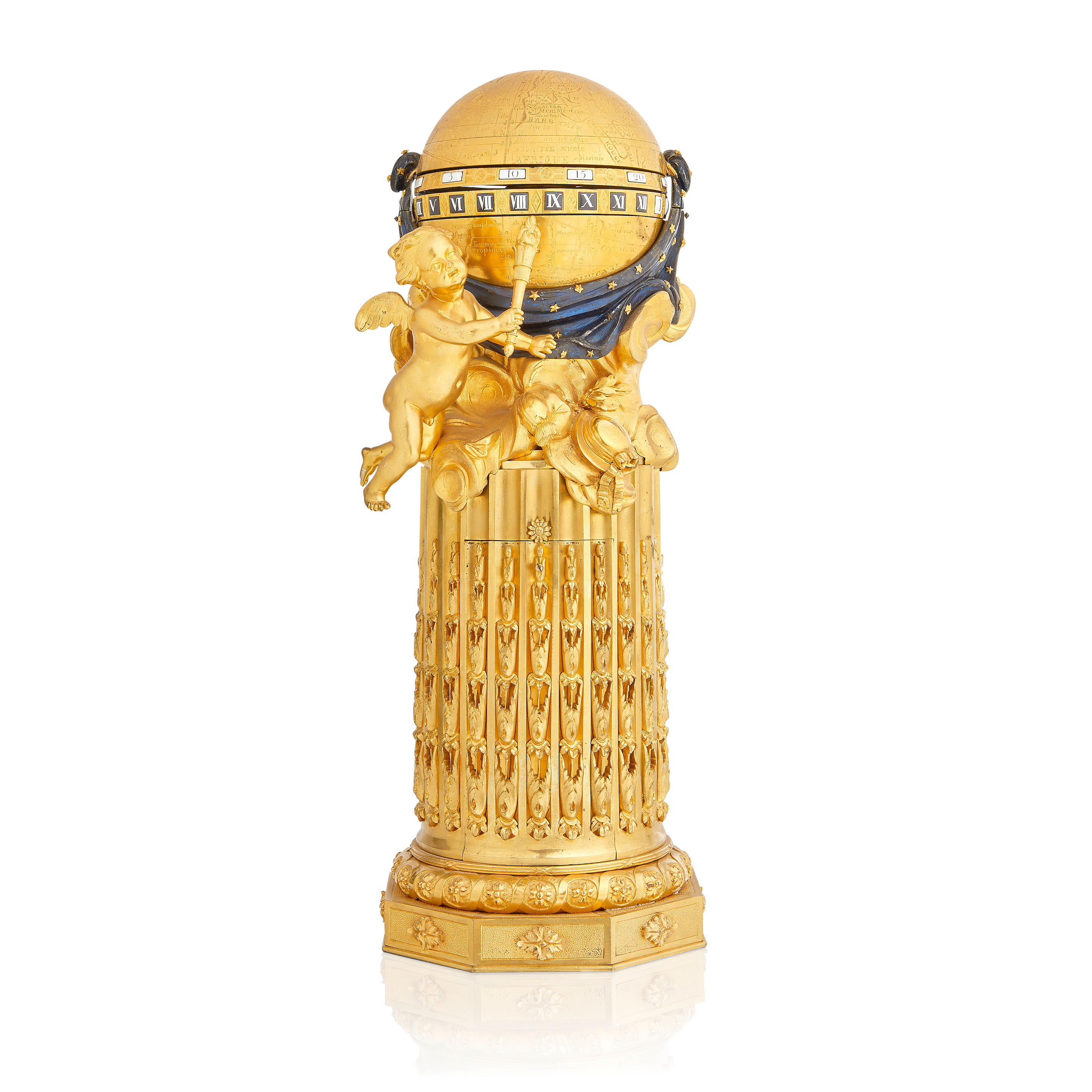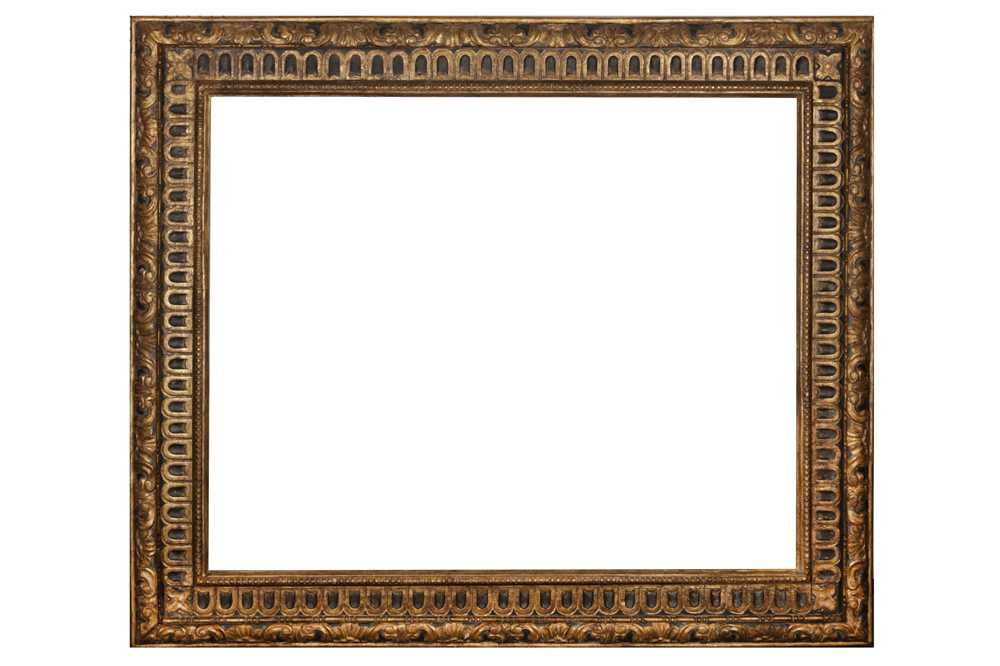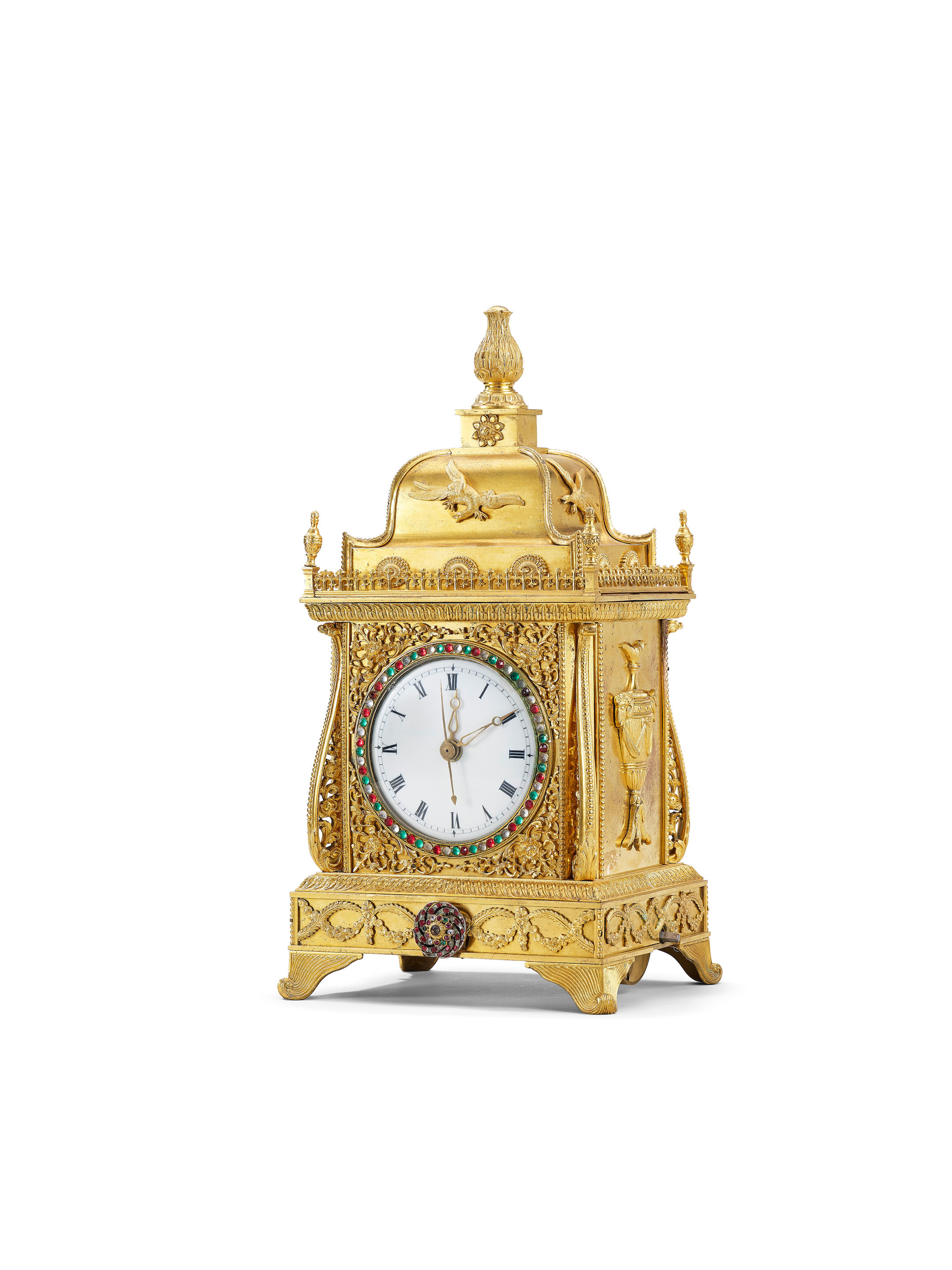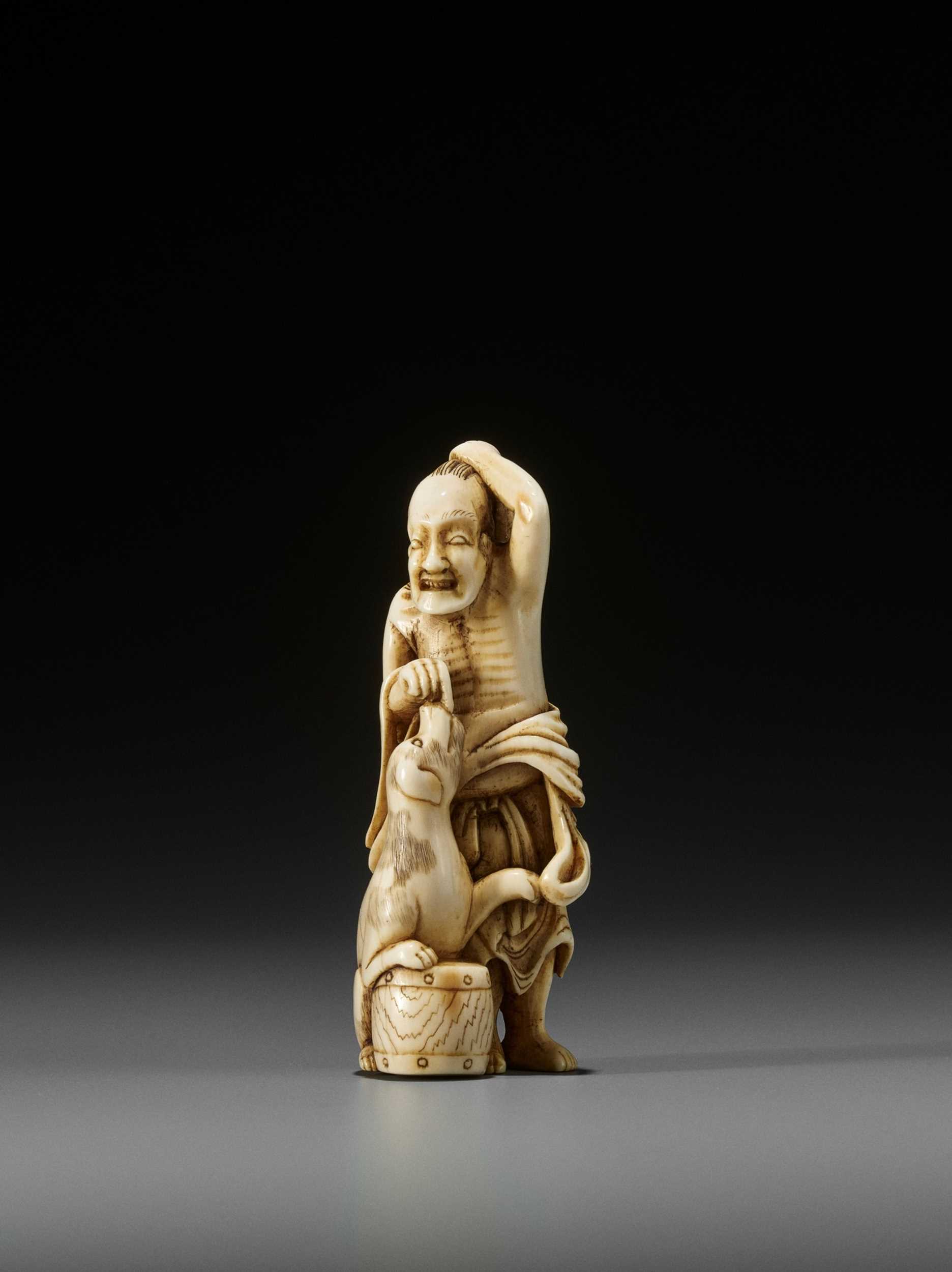An exceptional late 18th century French gilt and patinated bronze pendule à cercle tournant timepiece dated 1780Lepaute, Paris
The case surmounted by a 5 inch spherical gilt globe engraved with a map of the world and displaying the time at the equator via twin horizontal rotating bands, the uppermost with 12 white enamel five-minute Arabic cartouche numerals, over 24 larger Roman cartouche numerals (12 with black numerals on a white ground to denote daytime, 12 with white numerals on a black ground to denote night-time), the globe draped in a midnight blue metal cloth studded with brass stars, a flying cherub below holding a flaming torch to indicate the time; all supported on a crisply cast Corinthian reeded column on an octagonal base.
The rectangular movement set within the column and accessed via a door to the font, with pin-wheel escapement driving a vertical arbor via a contrate wheel up into the globe, the striking via an outside countwheel strike on a bell. Signed along the lower edge LE PAUTE. H.ger DU ROI APARIS 1780. Together with a winding key and Insurance Certificate from J. Kugel, Antiquaires, Paris dated 1996.
16 wide x 16 deep x 42 high (6in wide x 6in deep x 16 1/2in high)FootnotesThe Lepaute family is rightly regarded as one of the foremost horological dynasties working in 18th century France. Perhaps the best known member is Jean-André Lepaute (also spelled Le Paute), born in 1720 in Thonne-la-Long, a small town in north-eastern France. Lepaute was one of nine children, who were supported by their father, a farrier. Lepaute served his horological apprenticeship in the nearby town of Carignan, before moving to Paris in 1740. He immediately established a workshop, which was evidently prosperous as he encouraged one of his younger brothers, Jean-Baptiste, to join him in 1747, around which time the workshop was well known for making turret clocks. Two years Jean-Andre married Nicole-Reine Étable de la Brière, who was a celebrated astronomer and savant. In 1759, she helped to predict the path of Halley's Comet and was described as 'a human calculator'. She was also responsible for any horological calculations needed in the workshop (e.g. pendulum oscillation, etc.).
Two years after his marriage, Lepaute invented a clock which worked with only one wheel; he presented this to Louis XV, receiving the commendation of Horologist to the King. He also developed modifications to the double virgule escapement in 1753 although this caused controversy when another horologist, Pierre Augustin Caron, insisted he was the original maker. The Academie Royale des Sciences initially agreed that Caron was the original inventor, though this decision was later reversed and both were deemed to have created the escapement independently of one another. In 1755, the elder Lepaute published his Traité d'Horlogerie, with Nicole-Reine helping with the calculations. He was named maître in 1759, with Jean-Baptiste becoming maître in 1776, and he became increasingly involved with the Galeries du Louvre, where both he and Nicole-Reine had lived since 1756. Around this time, he appears to have left Jean-Baptiste to manage the workshop. Throughout this period Nicole-Reine continued to publish astronomical papers and contribute chapters to astronomical books, including a widely circulated table in 1764 for the calculation of the solar eclipse occurring on 1 April.
In 1774, Jean-Andre Lepaute formally retired from the workshop, and both he and Nicole-Reine moved to St. Cloud. He died in 1788, a year after his wife. Jean-Baptiste retired in 1789, leaving the workshop to his two nephews, both of whom were trained horologists. Jean Baptiste died in 1802, though the Lepaute workshop carried on under first the two nephews, and then their descendants, until 1952.
The Lepautes supplied clocks to some of the most prestigious sittes, including the Luxembourg Palace in Paris, the Palais Royal and the Military Academy in St. Hubert, among others. In addition to turret clocks, the workshop produced a multitude of mantel clocks, usually with a figural bronze case, often featuring characters from Ancient Greek or Roman mythology. A version of the globe clock was offered for sale from their workshop in 1766 for 2,500 livres; one of the costliest mantel clocks they produced at that time.
Literature
A Chapiro, La Montre Française. Paris: Éditions de l'Amateur, 1991.
Tardy, Dictionnaire des Horlogers Français, 127th edition, Aubenas: Lienhart et Cie, 1972.
P. Garcelon, Nicole-Reine Lepaute (1723-1788), 2022. Available at: https://pg-astro.fr/grands-astronomes/le-grand-siecle/nicole-reine-lepaute.html
University of St. Andrews School of Mathematics and Statistics, Nicole-Reine Etable de Labrière Lepaute, 2008. Available at: https://mathshistory.st-andrews.ac.uk/Biographies/Lepaute/
Comparable literature
J-D. Augarde, Les Ouvriers du Temps, Antiquorum and the Trustees of the Wallace Collection, p.26, fig.12.
A similar case but with patinated column was sold Christies, New York, Dalva Brothers: Parisian Taste in New York, 22 October 2020, lot 171.
An exceptional late 18th century French gilt and patinated bronze pendule à cercle tournant timepiece dated 1780Lepaute, Paris
The case surmounted by a 5 inch spherical gilt globe engraved with a map of the world and displaying the time at the equator via twin horizontal rotating bands, the uppermost with 12 white enamel five-minute Arabic cartouche numerals, over 24 larger Roman cartouche numerals (12 with black numerals on a white ground to denote daytime, 12 with white numerals on a black ground to denote night-time), the globe draped in a midnight blue metal cloth studded with brass stars, a flying cherub below holding a flaming torch to indicate the time; all supported on a crisply cast Corinthian reeded column on an octagonal base.
The rectangular movement set within the column and accessed via a door to the font, with pin-wheel escapement driving a vertical arbor via a contrate wheel up into the globe, the striking via an outside countwheel strike on a bell. Signed along the lower edge LE PAUTE. H.ger DU ROI APARIS 1780. Together with a winding key and Insurance Certificate from J. Kugel, Antiquaires, Paris dated 1996.
16 wide x 16 deep x 42 high (6in wide x 6in deep x 16 1/2in high)FootnotesThe Lepaute family is rightly regarded as one of the foremost horological dynasties working in 18th century France. Perhaps the best known member is Jean-André Lepaute (also spelled Le Paute), born in 1720 in Thonne-la-Long, a small town in north-eastern France. Lepaute was one of nine children, who were supported by their father, a farrier. Lepaute served his horological apprenticeship in the nearby town of Carignan, before moving to Paris in 1740. He immediately established a workshop, which was evidently prosperous as he encouraged one of his younger brothers, Jean-Baptiste, to join him in 1747, around which time the workshop was well known for making turret clocks. Two years Jean-Andre married Nicole-Reine Étable de la Brière, who was a celebrated astronomer and savant. In 1759, she helped to predict the path of Halley's Comet and was described as 'a human calculator'. She was also responsible for any horological calculations needed in the workshop (e.g. pendulum oscillation, etc.).
Two years after his marriage, Lepaute invented a clock which worked with only one wheel; he presented this to Louis XV, receiving the commendation of Horologist to the King. He also developed modifications to the double virgule escapement in 1753 although this caused controversy when another horologist, Pierre Augustin Caron, insisted he was the original maker. The Academie Royale des Sciences initially agreed that Caron was the original inventor, though this decision was later reversed and both were deemed to have created the escapement independently of one another. In 1755, the elder Lepaute published his Traité d'Horlogerie, with Nicole-Reine helping with the calculations. He was named maître in 1759, with Jean-Baptiste becoming maître in 1776, and he became increasingly involved with the Galeries du Louvre, where both he and Nicole-Reine had lived since 1756. Around this time, he appears to have left Jean-Baptiste to manage the workshop. Throughout this period Nicole-Reine continued to publish astronomical papers and contribute chapters to astronomical books, including a widely circulated table in 1764 for the calculation of the solar eclipse occurring on 1 April.
In 1774, Jean-Andre Lepaute formally retired from the workshop, and both he and Nicole-Reine moved to St. Cloud. He died in 1788, a year after his wife. Jean-Baptiste retired in 1789, leaving the workshop to his two nephews, both of whom were trained horologists. Jean Baptiste died in 1802, though the Lepaute workshop carried on under first the two nephews, and then their descendants, until 1952.
The Lepautes supplied clocks to some of the most prestigious sittes, including the Luxembourg Palace in Paris, the Palais Royal and the Military Academy in St. Hubert, among others. In addition to turret clocks, the workshop produced a multitude of mantel clocks, usually with a figural bronze case, often featuring characters from Ancient Greek or Roman mythology. A version of the globe clock was offered for sale from their workshop in 1766 for 2,500 livres; one of the costliest mantel clocks they produced at that time.
Literature
A Chapiro, La Montre Française. Paris: Éditions de l'Amateur, 1991.
Tardy, Dictionnaire des Horlogers Français, 127th edition, Aubenas: Lienhart et Cie, 1972.
P. Garcelon, Nicole-Reine Lepaute (1723-1788), 2022. Available at: https://pg-astro.fr/grands-astronomes/le-grand-siecle/nicole-reine-lepaute.html
University of St. Andrews School of Mathematics and Statistics, Nicole-Reine Etable de Labrière Lepaute, 2008. Available at: https://mathshistory.st-andrews.ac.uk/Biographies/Lepaute/
Comparable literature
J-D. Augarde, Les Ouvriers du Temps, Antiquorum and the Trustees of the Wallace Collection, p.26, fig.12.
A similar case but with patinated column was sold Christies, New York, Dalva Brothers: Parisian Taste in New York, 22 October 2020, lot 171.















Testen Sie LotSearch und seine Premium-Features 7 Tage - ohne Kosten!
Lassen Sie sich automatisch über neue Objekte in kommenden Auktionen benachrichtigen.
Suchauftrag anlegen